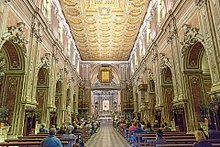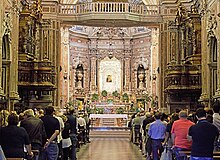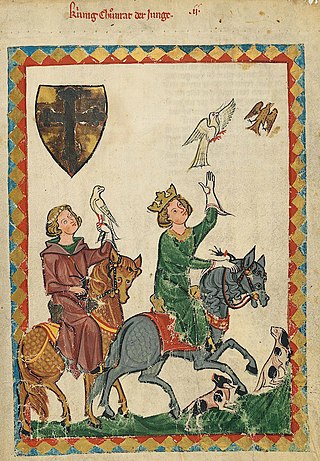
Frederick I of Baden, a member of the House of Zähringen, was Margrave of Baden and of Verona, as well as claimant Duke of Austria from 1250 until his death. As a fellow campaigner of the Hohenstaufen king Conradin, he likewise was beheaded at the behest of King Charles I of Naples.

Cosimo Fanzago was an Italian architect and sculptor, generally considered the greatest such artist of the Baroque period in Naples, Italy.
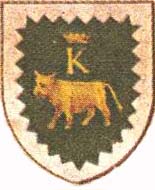
The House of Bove is an ancient noble patrician family of Ravello, Maritime Republic of Amalfi that held royal appointments in the Kingdom of Naples, and presided over feudal territories. After the dissolution of noble seats of the Kingdom of Naples in 1800 they were ascribed in the Libro d'Oro of Ravello. The Bove coat of arms is prominently displayed in the Duomo of Ravello.

Santa Maria dei Miracoli and Santa Maria di Montesanto are two churches in Rome.

Pacentro is a comune of 1,279 inhabitants of the province of L'Aquila in Abruzzo, Italy. It is a well-preserved historic medieval village located in central Italy, several kilometers from the City of Sulmona about 170 kilometres (110 mi) east of Rome. It is one of I Borghi più belli d'Italia.

Castel Nuovo, often called Maschio Angioino, is a medieval castle located in front of Piazza Municipio and the city hall in central Naples, Campania, Italy. Its scenic location and imposing size makes the castle, first erected in 1279, one of the main architectural landmarks of the city. It was a royal seat for kings of Naples, Aragon and Spain until 1815.

Sant'Anna dei Lombardi,, and also known as Santa Maria di Monte Oliveto, is an ancient church and convent located in piazza Monteoliveto in central Naples, Italy. Across Monteoliveto street from the Fountain in the square is the Renaissance palace of Orsini di Gravina.

Mercato is a neighbourhood or quartiere of Naples, southern Italy. It is in the southeastern part of the city, bounded by the industrial port of Naples on the south.

Paolo de Matteis was an Italian painter.

San Paolo Maggiore is a basilica church in Naples, southern Italy, and the burial place of Saint Cajetan, founder of the Theatines. It is located on Piazza Gaetano, about 1-2 blocks north of Via dei Tribunali.

The Cimino family, Cimini or Cimina The name refers to the cumin. Whether all beares of this name are related can most likely be dismissed, the variations of the spelling and transcript will vary from source to source, and as research goes on it may change the information in this article. The origin of the name is disputed, but it is certain that a branch of the family has taken the name from the Cimini Hills, in Latium. The origin of the Cimini name in this context goes back to the Etruscan era. The use of Cimini as a family name can be traced through history. In a study of family names in Roman Legions, the name DeCiminus is found C. Catullius DeCiminus of Troyes was a Roman Federal priest of the Roman Cult in 210 AD, who dies in Lyon. The name Ciminius is also documented in "Repertorium nominum gentilium et cognominum latinorum" The "Journal of Archaeology" states "Ciminius" as a known gentilitium nomina in ancient Rome. The ending "nius" is a clear indicator to the names Etruscan origin (which also may have the ending "na". C. Ciminius is registered as vicomagister of the vicus Silani Salienti first half of the first century, under the reign of Claudius.

Santa Maria del Carmine is a church in Pavia, Lombardy, northern Italy, considered amongst the best examples of Lombard Gothic architecture. It was begun in 1374 by Gian Galeazzo Visconti, Duke of Milan, on a project attributed to Bernardo da Venezia. The construction followed a slow pace, and was restarted in 1432, being finished in 1461.

Christianity and religion in general has always been an important part of the social and cultural life of Naples. It is the seat of the Archdiocese of Naples, and the Catholic faith is highly important to the people of Naples and there are hundreds of historic churches in the city. The Cathedral of Naples is the most important place of worship in the city, each year on September 19 it hosts the Miracle of Saint Januarius, the city's patron saint. In the miracle which thousands of Neapolitans flock to witness, the dried blood of Januarius is said to turn to liquid when brought close to relics said to be of his body: this is one of the most important traditions for Neapolitans.

Santa Maria del Carmine is a Roman Catholic church in Pisa, Italy known for its altarpiece.

San Martino church, also called San Martino Maggiore is a Gothic-style, Roman Catholic church located at the corner of Via Marsala and Via Guglielmo Oberdan in Bologna, region of Emilia Romagna, Italy. The church was founded by the adjacent Carmelite monastery. On 10 August 1704 via the authority of the Vatican Chapter, the venerated image of the Virgin of Mount Carmel was crowned by Pope Clement XI. On 25 August 1941, Pope Pius XII elevated it to the status of basilica.
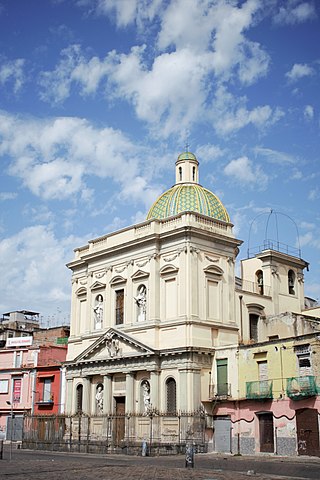
Santa Croce e Purgatorio al Mercato is a church in the center of the Piazza Mercato, in Naples, Italy.

The church of Santa Maria di Montesanto and the annexed monastery were built in Naples, Italy, by a community of Carmelite friars that had its origins in Montesanto, Sicily.

Santa Maria della Concordia is a baroque-style, Roman Catholic church, located on the Piazza of the same name in Naples, region of Campania, Italy.

Santa Maria Egiziaca a Forcella, also known as the Church of Santa Maria Egiziaca all'Olmo, is a Baroque-style, Roman Catholic church located in the quartiere di Forcella, in the city of Naples, Italy.
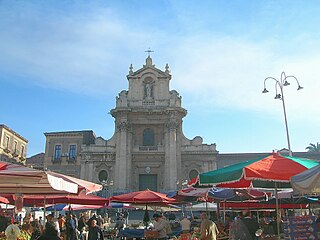
The Santuario della Madonna del Carmine also called Basilica di Maria Santissima Annunziata al Carmine, is a Roman Catholic minor basilica church and Marian sanctuary located on Piazza Carlo Alberto, in the town of Catania, Sicily.

